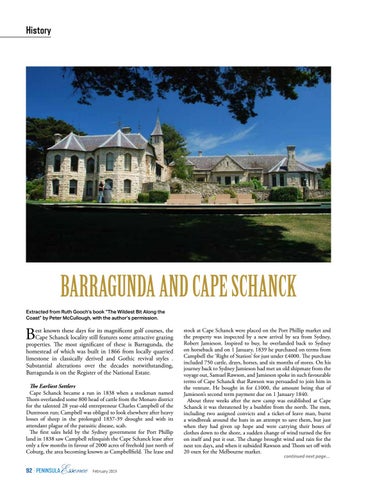History
BARRAGUNDA AND CAPE SCHANCK Extracted from Ruth Gooch’s book “The Wildest Bit Along the Coast” by Peter McCullough, with the author’s permission.
B
est known these days for its magnificent golf courses, the Cape Schanck locality still features some attractive grazing properties. The most significant of these is Barragunda, the homestead of which was built in 1866 from locally quarried limestone in classically derived and Gothic revival styles . Substantial alterations over the decades notwithstanding, Barragunda is on the Register of the National Estate.
The Earliest Settlers Cape Schanck became a run in 1838 when a stockman named Thom overlanded some 800 head of cattle from the Monaro district for the talented 28 year-old entrepreneur Charles Campbell of the Duntroon run; Campbell was obliged to look elsewhere after heavy losses of sheep in the prolonged 1837-39 drought and with its attendant plague of the parasitic disease, scab. The first sales held by the Sydney government for Port Phillip land in 1838 saw Campbell relinquish the Cape Schanck lease after only a few months in favour of 2000 acres of freehold just north of Coburg, the area becoming known as Campbellfield. The lease and
E ssence
92 | PENINSULA
February 2019
stock at Cape Schanck were placed on the Port Phillip market and the property was inspected by a new arrival by sea from Sydney, Robert Jamieson. Inspired to buy, he overlanded back to Sydney on horseback and on 1 January, 1839 he purchased on terms from Campbell the ‘Right of Station’ for just under £4000. The purchase included 750 cattle, drays, horses, and six months of stores. On his journey back to Sydney Jamieson had met an old shipmate from the voyage out, Samuel Rawson, and Jamieson spoke in such favourable terms of Cape Schanck that Rawson was persuaded to join him in the venture. He bought in for £1000, the amount being that of Jamieson’s second term payment due on 1 January 1840. About three weeks after the new camp was established at Cape Schanck it was threatened by a bushfire from the north. The men, including two assigned convicts and a ticket-of leave man, burnt a windbreak around the huts in an attempt to save them, but just when they had given up hope and were carrying their boxes of clothes down to the shore, a sudden change of wind turned the fire on itself and put it out. The change brought wind and rain for the next ten days, and when it subsided Rawson and Thom set off with 20 oxen for the Melbourne market. continued next page...
